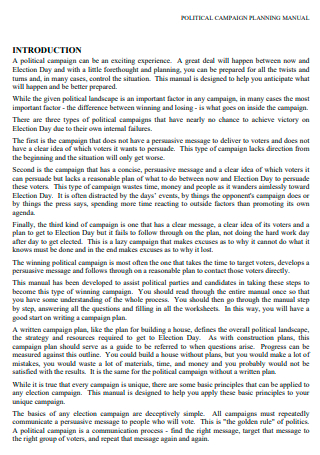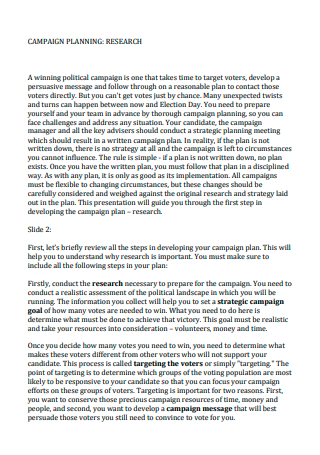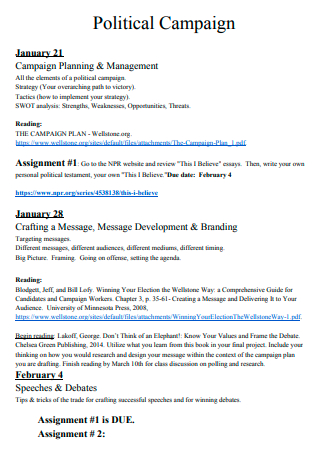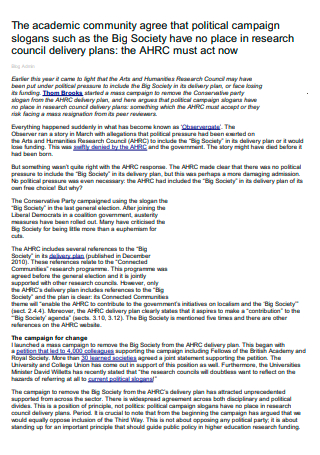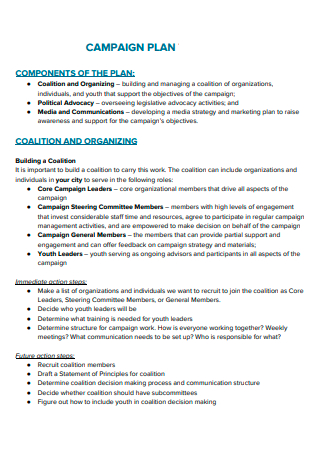5+ Sample Political Campaign Plan
FREE Political Campaign Plan s to Download
5+ Sample Political Campaign Plan
What Is a Political Campaign Plan?
What Are the Key Elements of a Campaign Strategy?
5 Tips For Writing A Powerful Political Campaign Speech:
6 Easy Steps for Successful Campaign Planning:
FAQs
What level of responsibility are you seeking?
What is political campaign management?
What are the disclosure requirements for a mass mailing sent by a candidate?
Can you get by with limited funding?
What Is a Political Campaign Plan?
A political campaign plan informs citizens about a political candidate running for the elected office. A campaign plan is a short-term integrated communications plan to generate lead or sales. Its purpose is to engage audiences, it normally has a content marketing focus and an integrated media schedule. A solid marketing campaign plan has clear, realistic goals which you can be confident of hitting. It is a systematized effort which seeks to influence the decision-making process within a specific group. In democracies, political campaigns often refer to electoral campaigns, where representatives are chosen or referendums are decided.
Convincing voters is the essence of a political campaign. Advertising, stump speeches, theme songs, and even negative campaigning have been around since a country began, and each advance in technology since then has offered new opportunities for candidates to persuade voters.
What Are the Key Elements of a Campaign Strategy?
This should be written clearly, in no more than two pages, and in an easily understandable manner. Describe the approach to crafting a campaign strategy that will accomplish the certain goals. Address the stakeholders, significant external influences, and any obstacles one can foresee. Also, highlight high-level advocacy priorities for the campaign, such as fostering relationships with influencers, engaging with the grassroots supporters, or lobbying on relevant and timely policy initiatives. Basically, summarize the context in which the organization is launching the digital campaign. Here are the key elements of a campaign strategy:
Target Audience. Try to figure out who you are trying to reach. Targeting a group as broad as “the general public” is far too inaccurate and can be a recipe for campaign disaster. A digital campaign should target a specific, primary audience and their motivators.
Personas. Describing the target audience in terms of a fictional character that represents them in general can help gain a better understanding of the groups you are engaging with, and helps better plan your communication with them.
Helpful questions to ask:
- How do they find, consume, and share content?
- What sort of job might this person have, and in what industry?
- What goals might this person have?
- What are their demographics?
- What are their biggest challenges and how do they work to overcome them?
Motivators. Get a better understanding of what motivates an individual in your audience and the group as a whole to take action. Using this understanding, try to align your campaign goals around what these audiences care about. Having the ability to target and predict donors removes the guesswork from list selection and segmentation, saving you time, effort, and resources throughout the process. This allows an organization to easily identify opportunities and raise more money, so you can optimize your programs for better outcomes.
Calls-to-Action (CTAs). The importance of including CTAs throughout a campaign matter. It is easy to forget that each CTA should call for a specific, intentional action that aligns with your key messaging. As with your sub-messages, craft these CTAs for specific channels and audience segments. Most essentially though, especially if the aim is fundraising, be sure the CTA directs your audience to an optimized and fool-proof donation page.
Media Mix. All of the media assets at your disposal fall somewhere in the framework of what’s called a “converging media mix.” This represents all of the communications channels and outreach efforts you’ll use during your campaign. There are four key strategy areas to this media mix: owned media strategies, earned media strategies, shared media strategies, and paid media strategies.
Key Messaging. The next step is to think about how to frame the campaign messaging after identifying the audience and what is important to them. One helpful step is to start by establishing a single, clear message you want to get across to an audience, and treat it as a core tenet of each part of your campaign. Then, craft a few sub-messages that can include specific wording you’d like to incorporate into your marketing collateral. These should be unique to specific channels, as well as specific segments of your audience.
Owned Media Strategies. Owned media strategies use the channels that your brand controls. This may include a website, campaign microsite, blog, videos, or other assets that you maintain as part of your content marketing strategy.
Pros: Great way to create long-term relationships with existing contacts; usually the most cost effective.
Cons: Take the longest to scale.
Earned Media Strategies. Once you get a buy-in from key influencers in your sphere, they will then share your content with their audiences, greatly boosting your campaign’s reach. Traditional PR, buzz, word-of-mouth advertisement, and blogger outreach all fall into the earned media category.
Pros: External endorsement from outside individuals and orgs; can significantly amplify the reach of your campaign.
Cons: Hardest to measure because you have limited control.
Shared Media Strategies. All social channels fall into this category because you “share” the media with those that choose to engage with you. Shared media includes any channel where you have some ownership, but not complete control. Shared media is vital to creating a conversation around your campaign—it is much easier to get earned media if there is chatter online about your campaign.
Pros: Best platform to create a conversation; helpful when trying to get earned media.
Cons: While you control what you say, you can really only control one side of the conversation.
Paid Media Strategies. Paid media strategies require payment to use a channel. The most effective ads will drive the target audience to owned media in order to create more earned, and shared media.
Pros: Harness the power and reach of social media; paid ad campaign opportunities are nearly endless.
Cons: It may take some time to establish a working knowledge of digital ad platforms.
Lastly, finish off your campaign plan with a two-phase timeline (setup and implementation), and a resource plan that explains how your project team will work. Include each member’s responsibilities, staff time allocation, any resources you will need, and a proposed budget.
5 Tips For Writing A Powerful Political Campaign Speech:
The most efficient speeches are those that use clear language in a series of short statements, and make the speaker’s points with persuasion. Here are 6 tips to creating an effective campaign speech:
6 Easy Steps for Successful Campaign Planning:
Whether you are looking to win support for an issue, impact policy, or inspire donors to take action and give, a campaign rarely succeeds without solid, thoughtful campaign planning. Here are six key steps to making a campaign plan together:
Step 1: Define the Victory
It is important that everyone agrees on the core goal or goals of your campaign. You also need to make sure the definition of your campaign’s success is specific and actionable. What exactly are you trying to accomplish? How will you know that you’ve hit your goal?
Step 2: Evaluate the Campaign Climate
Once you clearly define your campaign win, it’s time to evaluate the climate in which you’ll deploy your outreach. When you understand what’s going on with your issue or audience, you can plan to maximize the positives and strengthen any weaknesses. Identify what’s already working in your favor and what obstacles might cause your message to get lost or be misunderstood. Some questions to help you evaluate your issue’s climate:
- Is your issue hot on the agenda or stuck in limbo?
- Who else is working on this issue?
- What is the current conversation around your issue?
- What current events or opportunities can you use to your advantage?
- Who is the opposition and what is their agenda?
Step 3: Chart the Course
Lay out the series of milestones that you must hit on your way to reach your goal. Ideally, these steps should build off each other and indicate that your campaign is gaining momentum. Focus these milestones on the desired outcomes, rather than the tactics themselves. For example, if your campaign will reach out to local businesses to gain sponsors, your milestone should not be pitching these business owners. Rather, it should be that you reach your desired number of confirmed business partners for your cause.
Step 4: Choose Your Influence Strategy
Along with each step, understand the decision-makers who will determine your success. These may be voters, business partners, or public officials. Then, find out who will have the most influence on these decision-makers. These are the people you want to reach and activate to help your initiative gain momentum. Warning: avoid naming broad groups such as “the general public,” “voters” or “women.” Get very specific about your influencers so you have a clear picture of the kind of person you need to reach to achieve victory just as you did with your campaign goal.
Step 5: Message for Impact
All campaigns benefit from a messaging platform that provides everyone in your organization with a consistent positioning statement. Keep in mind that a messaging platform doesn’t need to be rigid, nor does it need to be memorized, but it should provide the core concepts and talking points to serve as a guide for your spokespeople. A good message platform includes the following four points:
- explain the problem/need that currently exists or the situation that you are working to change
- explain the result that a campaign victory will have and how it solves the problem you noted at the start
- specify what your campaign is working to accomplish
- describe how you recommend addressing the need or problem, along with specific actions that decision-makers need to take
Step 6: Manage Your Campaign
Once you outline the main tactics to achieve the goals, you still need to plan the day-to-day details to get it done. Each assignment should have a deadline/timeline, owner, metrics including outcomes, and a budget. When it comes to metrics, it’s important to think of ones that lead to outcomes. Don’t forget to celebrate the small victories with your team to keep everyone motivated once the campaign is underway.
FAQs
What level of responsibility are you seeking?
You may find yourself in a relatively senior post on a small campaign—perhaps even running it—with little experience but a high level of motivation and competency. Good campaigns are meritocracies, and you can rise quickly if you earn it. Hence, it can be a little more challenging to secure a position with a lot of responsibility for one of the major parties’ presidential campaigns.
What is political campaign management?
A campaign manager, campaign director, or campaign chairman is a paid or volunteer individual whose role is to coordinate a political campaign’s operations such as fundraising, polling, advertising, getting out the vote, and other activities supporting the effort, directly.
What are the disclosure requirements for a mass mailing sent by a candidate?
When a candidate sends a mass mailing—more than 200 pieces of the same or similar mail in a calendar month, the words “paid for by” and the name and address of the candidate’s committee must appear on the outside of the mailing in no less than six-point type and in a color that contrasts with the background. If two or more candidate-controlled committees pay for the mailer, the name and address of at least one of the committees must be shown on the outside and the names and addresses of all committees must appear on at least one insert.
Can you get by with limited funding?
Sometimes, the biggest campaigns can also rely on a steady flow of volunteers and have less need to bring on non-essential paid staff.
The way that we choose to regulate a new form of communication must take into account the unique characteristics of the technology behind it. It is important to note that microtargeting’s impact on democracy is not all bad. It lets for smaller and less-well-funded campaigns to reach voters because online ads tend to be much less expensive than on TV and radio spots. It also allows candidates to hone in on real and particular issues that matter to their potential constituents, as opposed to the more vague and generic messages that tend to run on traditional media—this, in return, can expand voter engagement and turnout.

